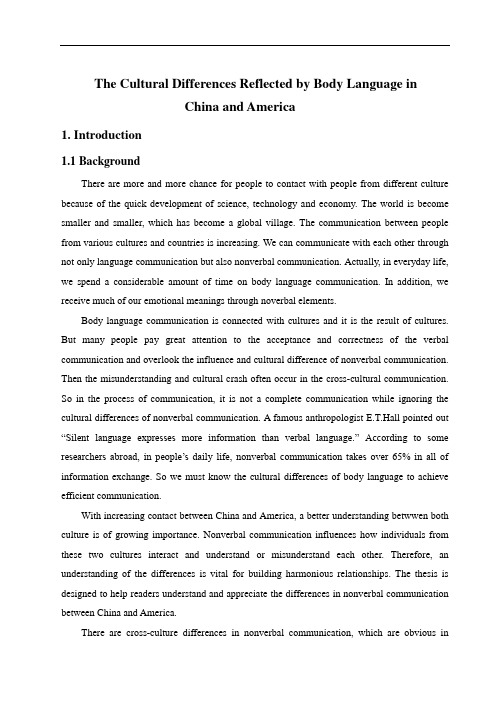英语语言文化方面论文优秀范文
语言文化意识在PEP初中英语教材中体现论文

语言文化意识在PEP初中英语教材中的体现引言人类学家泰勒曾说:文化是人类在社会发展过程中创造的精神财富和物质财富的总和。
而语言是人类特有的一种符号系统,每一种语言都是在特定的社会历史环境中产生和发展起来的,因此,每一种语言都反映出使用该语言的国家和民族在不同的社会历史时期所特有的文化现象。
因此,要学好一种语言,对该语言的相关知识的了解是至关重要的。
语言是文化的载体,它反映了一个社会的变化,并在特定的社会历史环境中产生和发展。
不同的民族由于自然、地理环境、历史背景和宗教信仰的差异,形成了千差万别的文化,(梁妍,2009)他们的价值观念、风俗习惯、思维方式以及道德标准都存在很大的差异。
所以在语言学习过程中,语言知识、语言技能不是唯一的学习内容,文化因素的作用不可低估,要通过扩大学生接触异域文化的范围,提高他们对中外文化异同的敏感性和鉴别能力。
同时在英语的使用上,文化背景也是不可忽视的,不然很多中国人会不自觉地套用中国的文化观念,运用中国人的交际模式,于是常常陷入尴尬的境地。
“跨文化交际”即“inter-culturalcommunication”或“cross-culturalcommunication”。
它指本族语者与非本族语者之间的交际,也指任何在语言和文化背景方面有差异的人们之间的交际 (鲍明捷,2002)。
由此可见,,在交流中语言环境不同的人如果总喜欢用自己的思维方式来解释对方的话语,这就可能对对方的话语做出不准确的推论,从而产生冲突和障碍。
所以这就要求广大英语教师要把跨文化教育列入英语教学一个重要环节。
“这样既能提高中小学教师的英语教学理论水平、教学的方法和技巧,又能通过参与、实践、讨论、探究、反思等学习活动提高学生的英语语言的实际运用能力。
”(王蔷,2008)英语教学的最终目的是培养学生运用英语进行交际的能力,教师如果忽视文化差异地传授知识,会导致学生在交际中走入迷茫从而没有实现自己的交流目的。
英语语言学论文(优秀9篇)

英语语言学论文(优秀9篇)《浅析美国英语与英国英语的区别及应用》摘要:标准现代英式英语和美式英语,虽然两者互相理解没有很多实质性的差异,但对两者的各方面进行一个大概的比较,还是有很多细微的差别的。
关键词:美国英语;英国英语;分析对比;区别及应用在全球一体化的背景下,英语已成为世界通用语言,在社会生活、交往或交流中都扮演着重要角色。
近年,美式英语风靡全球,尽管美式英语和英式英语都是英语,但是区别甚多。
相对来说美式英语便捷实用,英式英语较为复杂。
英式英语保守、严谨,美国人说英语则是另一种姿态,崇尚可见即可读。
1.两种语言在历史演变、地域文化、社会地位层面的区别。
英语是全世界几千种语言的其中一种,也是印欧语系一百多种语言之一、英国英语距今已有1500的历史了。
而美国英语是在英国英语的基础上发展而来的。
英国和美国在政治、经济、文化等方面的不断发展,造就了它们各自不同的语言特征。
美式英语起源于18世纪70年代,美国的独立战争爆发时,战乱的特殊原因导致绝大多数美国人来自欧洲移民,尤其以英格兰人为主,大多讲英国英语。
近几十年来,由于美国的贸易、军事、科技、国际地位等方面远远超过英国,再加上美国电影风靡全球,促使美国本土的俚语很多已经渗透到了口语之中。
很多因素导致美式英语成为强势语言。
2.发音方面存在的不同。
英语和美语的发音最具代表性的区别是对er的发音的不同。
英语中,短音的er是的浑元音,但长音的er是个拉长了的浑元音,听起来是一个介于“俄”和“啊”的声音。
而美语中,er听起来怎么都是个“儿”音。
ar:除了轻读短音(如singular)和者后连元音(如clarity),英语的ar全部清一色的长音[a:],而美语中,是“阿尔”。
英语和美语的辅音基本是一致的,但在使用习惯上也有些差别。
如词组clear animosity,英语会读成clear,animosity,而美语会读成clear—ranimosity。
另一个比较明显的区别是d和t。
英语论文(中美文化差异)

英语论文(中美文化差异)英语论文(中美文化差异)一、引言英语作为一门全球通用语言,对于中美文化交流具有重要意义。
本篇论文旨在探讨中美文化差异,并分析这些差异对语言和交际的影响。
二、中美价值观差异在中美文化中,价值观差异是最明显的方面之一。
中美两个国家有着不同的历史、宗教和社会背景,这导致了他们在价值观上存在一定的差异。
1. 个人主义与集体主义美国文化倾向于个人主义,注重个体的独立和自主性。
而中国文化则强调集体主义,重视家庭和团体的集体利益。
这种差异在语言交际中表现明显,比如在表达感谢之情时,美国人更倾向于使用“I thank you”这样的第一人称表达方式,而中国人则更倾向于使用“We thank you”来强调团体的感谢之情。
2. 时间观念与未来导向美国人注重效率和时间观念,强调将时间用于创造价值。
相比之下,中国文化更加注重历史和传统,对未来的展望较为谨慎。
这种差异在商务交流中体现明显,美国人常常在商务会议上强调时间管理和准时守约,而中国人更注重人际关系的建立和发展。
三、语言差异中美文化差异也在语言使用上得到体现。
1. 礼貌用语中美两国在礼貌用语方面存在差异。
美国人更倾向于使用直接的表达方式,比如“Please pass the salt”。
而中国人常常使用委婉的方式,比如“麻烦你帮我递一下盐”。
这种差异反映了中美两国之间在社交场合中的不同习惯和礼貌观念。
2. 言语间断和暗示中美文化中存在着对言语间断和暗示的不同需求。
美国人更倾向于直接了当地表达自己的意图,喜欢在交流中保持比较连贯的语言流程。
而中国人更喜欢使用间接的方式表达自己的意图,有时候在表达上更多地依靠暗示和上下文的理解。
这种差异在商务谈判和日常社交中都能观察到。
四、沟通方式差异受到文化差异的影响,中美人民在交际中采用不同的沟通方式。
1. 非语言表达在非语言表达上,中美文化也存在着差异。
美国人更加直接和开放地表达情感,通过面部表情、肢体动作和眼神交流来表达自己的意思。
英语论文 从中美肢体语言体现的文化差异

The Cultural Differences Reflected by Body Language inChina and America1. Introduction1.1 BackgroundThere are more and more chance for people to contact with people from different culture because of the quick development of science, technology and economy. The world is become smaller and smaller, which has become a global village. The communication between people from various cultures and countries is increasing. We can communicate with each other through not only language communication but also nonverbal communication. Actually, in everyday life, we spend a considerable amount of time on body language communication. In addition, we receive much of our emotional meanings through noverbal elements.Body language communication is connected with cultures and it is the result of cultures. But many people pay great attention to the acceptance and correctness of the verbal communication and overlook the influence and cultural difference of nonverbal communication. Then the misunderstanding and cultural crash often occur in the cross-cultural communication. So in the process of communication, it is not a complete communication while ignoring the cultural differences of nonverbal communication. A famous anthropologist E.T.Hall pointed out “Silent language expresses more information than verbal language.” According to some researchers abroad, in people’s daily life, nonverbal communication takes over 65% in all of information exchange. So we must know the cultural differences of body language to achieve efficient communication.With increasing contact between China and America, a better understanding betwwen both culture is of growing importance. Nonverbal communication influences how individuals from these two cultures interact and understand or misunderstand each other. Therefore, an understanding of the differences is vital for building harmonious relationships. The thesis is designed to help readers understand and appreciate the differences in nonverbal communication between China and America.There are cross-culture differences in nonverbal communication, which are obvious inmany aspects. Gestural symbols play a large part, and because this is true, gestural emblems are highly sensitive. The same body language have different interpretation because of different cultures. Different body language can be used in different background, however, they can express the same siginificance.To master the nonverbal communication is a necessary part for those who come from different culture. Some people find it difficult to understand the nonverbal code. Because they do not know the background of body language.1.2 SignificanceBody language communication is very important in people communication because it can help us cause first impressions. Think for a while we often judge a person coming from nonverbal information, especially body language. It is important many original information usually can have intuitive recognition. Even how we choose a partner is based on the people who give us the first impression. For example, a famous Chinese proverb going on “fall in love at first sight.” Whether we can have a long-term association with other person also based on the first impression.Body language is so important that some people think of body language as equal to nonverbal communication. More and more people realize the importance of body language communication. We can know more about people’s instinctive feelings situation grounded on their behavioral communication. For example, when we notice a person closing finger tightly with stern appearance, we can judge that this person is sad based on his action. When we are hearing people with shaking sound and noticing them with quivering hands, we can judge that this person is mentally troubled regardless of their saying. Our feelings are showed in our gesture, posture, facial expression and eye contact-it can be happy, sad, anxious and anger and so on. Therefore, we can show our attitude and express ourselves without speaking anything. Because of this, we depend largely on what we have learned coming from our eyes. Many researcher make know that we will rely heavily on non verbal communication rather than verbal ones when they are in conflict with each other.When we come to realize that the nonverbal communication is very important, it is apparent that nonverbal behavior can communicate(convey)people’s physical as well asmental situation. The importance of nonverbal behavior is apparent if we realize that in one form or another, all of our actions convey information about our psychological and physical states. A stroking of the the chin, bow, wave, pointed finger, or yawn all have a message. Our actions, in addition of those association with some illness, have some rules; in a particular way, they stand for outsider speaking to insider. And it is very significant, those behaviors show the time, be it turning to face in another direction from people with whom we feel uneasy. It is very important for us to expain correctly behavioral communication of people who come from other cultures.It is well know that some nonverbal actions have close connection with culture. The body language may lead to understand incorrectly for people of different behaviors who send the same message with different gestures of the body. Misunderstanding can cause the feeling of offence, insult. From these reason, I think that it is highly necessary to make cross-cultural studies of the body language.2 Definition and functions of body language2.1 Definition of body languageBody language, also called body movements, body behavior and so on, refers to all expressions and movements that send communicative messages. Body language is a process in which communicators use the natural features of their bodies to deliver information and express specific meaning instinctively to the other communicator. We will discuss it in details later. It used by people for sending messages to one another. It is very useful because it can help you make yourself easily understood.Different scholars have made various efforts to define it. Accoring to Knapp the phrase‘nonverbal communication’ reffered to communication effect by means other than words. Some linguist also claimed that body language could be without the use of words. Other linguists took into account social cinventions in defining body language. Besides social conventions, many oter factors are also important in helping convey nonverbal meanings. The meanings of body language often have to be interpreted via considerations of such aspects, because these factors may help make clear the complexity of bodylanguage.However, these factors are so diliverse and complex that a perfect definition is impossible. It is so natural that current definitions are different from the ones in their orientations.2.2 Functions of body languageBody language like verbal communication is also a part of culture and the carrier of a certain culture. The function of body language in the whole communication can’t be overlooked. “In the daily communication, we can see people can’t communicate effi ciently by verbal language alone. And nonverbal communication will express clear meanings in a certain context. And a certain nonverbal communication should be connected with verbal communication or the other nonverbal communication to provide correct info rmation.” So in communicative activities, body language also plays a great role. Of course, we should pay close attention to the functions of body language. “In any case, when verbal communication conflicts with no nverbal communication, people are willing to accept the information nonverbal communication delivers. Because nonverbal communication sounds more natural, more instinctive and it is hard to pretend.”Obviously, we should make full use of body language to achieve efficientcommunication. Now, we will discuss the functions of body language.Nonverbal communication ofen performs one of several functions in relationship to verbal communication. These functions help us to understand and use communication more effectively. Nonverbal messages serve six major functions: repetition, contradiction, substitution, accentuation, supplementation or modification and regulation.Repetition is defined as the process of reinforcingverbal messages through redundancy. People often use nonverbal messages to repeat apoint they are trying to make. For example, when we tell people how to get to the nearest hospital, we are not only telling them the direction but also pointing to the direction with hands. Generally speaking, the gestures and words have a similar meaning and reinforce one another.Contradiction is the opposite of repetition; it negates the verbal message. On some occasions, our nonverbal actions send signals opposite from the literal messages contained in our verbal messages. For instance, you tell someone you are relaxed and at ease, yet your voice quavers and your hands shake.Substitution. We use substitution in body language when we perform some action instead of speaking. If a group of people is boisterous, you might place your index finger to your lips as an alternative to saying “please calm down so that I can speak”.Accentuation. For example, you may have noticed how some people tap the desktop with each word of an important message like “I want you to do this today”.Supplement. For instance, we greet people with a smile. Smile functions as a supplement to the pleasure of meeting people.Regulation occurs when nonverbal messages help to control the flow of verbal messages. We often regulate and manage communication by using certainform of body language. We nod our head in agreement to indicate to our communication partner that we agree and that he or she should continue talking or we have direct eye contact with someone to let him or her know the channels are open.Thus,body language function sometimes occur separately, and sometimes they occur at the same moment. Without them, we should have a very difficult time communicating.3 Cultural differences of body language betwwen Chinese and Americans3.1 Types and differences of body languageHere, we research into three elements of body language: gesture (head gesture, facial expressions, eye contact, arm gesture, hand gesture, and leg movement), posture(walking posture, standing posture, squatting posture, and sitting posture), and touch (ten distinctions concerning touching behaviors) Different believes are the causes of the differences of body language. According to the theories proposed by American anthologists Barnettt Pearce, Verrion Cronent, people’s behavior, the way of thinking and so on are aff ected by their believes. And every culture has its distinctive belief system. A normal action in this culture will be abnormal in another one. A positive behavior in one culture will be negative in another. People from eastern world advocate modesty, tolerance, mutual-support and responsibility for the group. But western people admire independence, self-respect, free development, and requiring individual space and so on. Next, we will go to the differences of body language from five parts.3.1.1 Head gestureChinese and American head gesture shares a number of similarities. For example: nodding the head up and down means “yes”, “I agree”; shaking the head side to side means “no”; heading forward shows an interest in the conversation; heding backward shows lack of interest and so on.As to the differences, a nod of the head in China can function as greeting and beckoning someone to come here, while the same function performed by the Americans is a raise of the head. Patting on head means differently in these two cultures. Occasionally, Chinese adults may pat the head of children to show affection; patting the head of a teenager or an adult would cause displeasure and can be insulting. Americans’ patting on other’s head is just for giving comfort, consolation or encouragement; and also for showing affection.A unique head gesture in China-tip the head backward and audibly suck air in through the teeth-meas “no”or “something is very difficult” and has the function of pausing to rethink. Also there are some head gestures use in America but seldom seen in China: scratching the head means thinking or confused or skeptical; chin stroke, tapping the head with forefinger showscontemplation; hand cutting across the top of the head shows impatience; head switching to one side with a rush or chin pointing to a certain direction function as beckoning someone to come here or pointing direction.3.1.2 Facial expressionsWe constantly read expressions from people’s face. In fact, facial cues are the single most important source of nonverbal communication.Facial expressions have some own features: they are innate and universal. Therefore, the expressions for happiness, sadness, disgust, fear, anger, and surprise (the six basic emotions) are recognized by most culture groups as having the same meaning. However, some variations also exist. Some facial expressions and their interpretations may vary from one culture to another.Generally speaking, Chinese people are more self-controlled, especially in formal, public occasions, and when communicate with strangers and foreigners, they tend to control their emotions. When in down spirits (sad, angry, contemptuous and so on), Chinese people usually try to sustain a neutral expression. The whole face is on a loose state, forehead and eyebrow are equable, lips close naturally, and eyes open looking forward-such kind of looks is considered to be a neutral expression. Differently, the Americans may show in their expressions immediately when they are in the same spirits. Controlling one’s bad mood properly is considered mature and well-educated in China. Therefore , they think the Americans’ lack of control their emotions as an illustration of puerility and philistinism; whereas the Americans may consider the Chinese to be wooden and slow.When expressing some positive emotions, such as compliment and sympathy, Chinese people sometimes have less sense of propriety in their exprssions than the Americans do. They think the more exaggerated the better. American people regard this as dishonest.In daily communication and daily behaviors, some differences cause by Chinese’s humility and Americans’ self-esteem are worth mentioning. When receiving honest praise from others, Chinese people usually send an expression showing “I don’t believe”, “no”, “I don’t deserve such praise”, and sometimes even give an anxious looks. American people think that such response is dishonest and hypocritical. On the contrary, they may smile to the person who praise them, accept the compliment and usually say “thank you”. In the Chinese point of view, such response is kind of pride and conceited.3.1.3 Smile and laughterWhen it comes to smile and laughter, the most common facial expressions, they may cause some misunderstandings between Chinese and American culture. Thus it is necessary to explore them further in this point. Smile and laughter usually convey friendliness, approval, satisfaction, pleasure, joy, merriment. This is generally true in China as well as in America. However, it may be difficult for Americans to believe that smiling for the Chinese not only means that someone is happy, but also that he or she is sorry. It is desirable for a Chinese to apologize with a smile, which indicates humbleness and embarrassment.3.1.4 Eye languageAs saying go es “The eyes are the window of the soul”. That is to say, we can read one’s mind through his or her eyes. Eye language can express complicated feelings and it is an important way to judge the intimacy of communicators. People from America have more eye contact than Chinese people when they are in conversation. According to American tradition, communicators must gaze at each other. “But there are many rules about eye language: Whether to look at the other communicator or not; when it is the time to look at them, how long we can look at; who we can look at and who we can’t; they all imply different meanings in communication.”Americans pay great attention to the time and the way of eye contact. In common conversation, they will look at each other about one minute and then they will look away. If two Americans gaze at each other, which indicate they are intimate. In North America, the children there have learned to look at the other communicator directly. If they don’t, they are regarded lack of enthusiasm or co nfidence. They believe the saying “Never trust a person who can’t look you in the eyes.” For showing politeness or respect, Chinese people frequently avoid direct eye contact with others.3.2 Gestures“Gesture means we communicate and express by the movement and manners of our hands and fingers.” In our daily li fe, every one makes gestures, but many gestures have distinct regional and cultural features. “Don’t assume that every one in the world understands one gesture in the same way.”For example, A mericans often touch their temples to express somebody’s cleverness. But。
英语教学中的文化意识(中学英语教学论文)

英语教学中的文化意识 (中学英语教学论文)蒲江中学李然【提要】:“文化可以解释为社会所做的和所想的,而语言则是思想的具体表达方式。
”由于语言是一种民族文化的表现与承载形式,不了解这个民族的文化,也就无法真正学好该民族的语言。
外语教学不仅要介绍语言知识并进行“四会”技能训练,更应该把这种学习与训练放到文化教学的大背景中进行,最终使学生具有语用能力。
而文化是指目的语所在国家的历史、地理、风土人情、传统习俗、生活方式、文学艺术、行为规范和价值观念等。
1 本文通过文化干扰对学生学习英语的影响进行归类分析,并结合外语教学,阐述重视文化教学,提高学生文化修养的重要性并如何进行文化意识的渗透。
【关键词】:文化意识文学修养文化渗透素质教育布卢姆说:人在学习上的潜力是极大的,只要教育得法,几乎每个人都能掌握中小学课程。
对此我们毋庸质疑。
作为一名中学的英语教员,在新的课程改革标准下,如何教育得法,卓有成效地进行现代化英语课堂教学值得我们深思和探讨。
不少所谓的“专家和学者”仍旧摆脱不了“穿新鞋走老路”的窠臼。
填鸭式的教学外加“应试教育向素质教育的转变”,我们的学生在劫难逃。
学习的被动成就了老师的主动,学生的兴趣成就了老师的泛泛而谈。
如何进行有效的管理,操纵课堂,不仅是一个老师驾驭能力的体现,更是一个老师综合素质的挑战。
我们都在谈提高学生的素质,如果作为一门外国语言教学的老师都“空”素质而又何谈学生的“实”素质呢?这两者的对立和统一需要我们英语老师在专业素质的基础上大力发掘学生的非智力因素,这种非智力因素对一个学生的人格修养和健全人格来说起着“唇亡齿寒”的功效。
学生不是机器,而是一个鲜明的活体。
这个活体“多动”、“多思”、“多问”,如何有效地解决这些问题,首当其冲的就是我们的老师如何提高学生学习的兴趣,并在了解外国文化背景的前提下,深知内外两种文化的迥然各异,在这种“外来文化意识”挑战“本国文化意识”的过程中,进行文化意识的渗透和教育,达到一种兴趣带动主动学习的景象。
英语教学文化观论文

英语教学文化观论文摘要:英语文化教学是语言教学的升华,是语言教学的生命源泉。
英语文化教学和英语语言教学正如一个硬币的正反两个面,两者相互依赖,缺一不可。
一、文化:英语教学的本质追求英语作为一种语言现象,英语学习是学习西方国家的语言,归根到底是学习他们的文化,如果仅仅单纯的学习一种语言,没有文化做支撑,就好像一滴水离开了大海,没有存活的源泉。
因此,我们学习英语要从更加广泛的意义去理解英语学习的本质——文化的学习。
(一)语言与文化的关系语言是人类社会发展的产物,随着人类社会的发展变化而不断发展。
那么究竟什么是语言呢?据潘文国先生的研究介绍,自十九世纪初以来,众多学者给语言共下过六十多种定义。
潘先生将这些语言定义分为四大类:第一类以斯大林为代表,强调语言是交际的工具,即“交际工具说”,这是语言的社会属性。
第二类以索绪尔为代表,强调语言本身就是一个复杂的系统,进行自我实现,即“自足系统说”,这是语言的自然属性。
第三类以洪堡特为代表,强调人类是文化历史的一部分,要求从人的角度用科学的方法去研究语言,即“世界观说”,是语言的历史文化属性。
第四类以乔姆斯基为代表,强调从人类自身出发,揭示语言的本能,要求用自然科学的方法去研究语言,即“本能说”。
在此,我比较赞同许国璋先生的说法。
语言是文化的符号表征,是人类交际的工具。
那么对文化又作何解释呢?其实至今文化也没有一个统一的定义,从词源上看,西方“文化”(culture)来源于拉丁语“cultura”,本意是土地耕种,神明祭祀,动植物培养,后来引申为精神修养等义。
之后又有不同的学者从不同的角度对文化的内涵进行了阐述。
香港学者鲁凡之先生认为“文化具有化人的本质性”:“‘文化’即‘人化’,人在回应环境挑战而反过来将环境‘人化’——不仅将外在于人的客观环境‘人化’,而且将人自身的主体‘人化’,即人由‘自存体’(in-itself)向‘自为体’(being for-itself)的转化或提升。
英语语言学论文六篇

英语语言学论文六篇英语语言学论文范文2[关键词]英美文学语言教学高校英语教学模式随着我国改革开放的深化和现代化进程的飞速进展,英语作为一门国际性语言,在社会的政治、文化、经济等各个领域对于人才的需求量与日俱增,高校的高校英语教育也正面临新的机遇和挑战。
众多高校英语老师都在不断地摸索,总结新的有效的教学策略和方法。
目前,许多老师在高校英语教学中,尝试使用多媒体教学,用丰富的视听材料给同学创设富有意义的课堂教学环境。
作为一种补充,在课堂教学中融入经典英美文学作品也不失为一种提高同学爱好,促进英语学习的有效途径。
英美文学教育,作为高校英语教育的一种重要手段,可以培育同学的思维力量、想象力以及制造力。
其功能和应用价值的体现不仅仅适用于英语专业高班级的同学,同时也适用于高校外语教学,而文学语言也可以作为英语语言学习的重要范本,在提高高校生人文素养情操及文学鉴赏力量的同时,提高同学的文学语言感悟力。
一、文学语言与英语语言技能的进展众所周知,语言是思想的直接实现,人靠语言来表达思想。
与其他艺术形式相比较,语言艺术有着极为丰富的思想容量。
作家可以直接将自己对生活的感受、体验、理解、评价及心情、情感渗透在作品中,从而以情达理,以理融情,情、理相生。
真正的文学大师笔下的语言是具有生命灵性的,它有声,有色,有味,有情感,有厚度、力度与质感,是应当细心去体会,沉吟,把玩,并从中感受到一种语言的趣味性。
因此语言的背后是人的心灵世界。
对文学语言美的敏感与驾驭力量,是提高人的精神境界,使人变得更加美妙的不行或缺的方面。
文学阅读的魅力与意义也就在于此。
目前的高校英语教学,仍旧停留在传统的单纯课文教学,语言点讲解等层面上,课本内容相对陈旧,老师的教学手段也并无创新之处。
其弊端是忽视英语的基本功能即表达功能,也忽视了同学在教学活动中的主体作用,另外还忽视了对同学英语学习爱好的培育,将生硬的课本内容强行“灌输”;至同学脑海中,使整个课堂教学环节缺乏生气,长此以往,高校英语教学将陷入僵局。
英语专业英语作文范文

英语专业英语作文范文Title: The Importance of Cultural Immersion in Language Learning。
In the realm of language learning, particularly in the field of English studies, the significance of cultural immersion cannot be overstated. It serves as a pivotal aspect in comprehending and mastering a language beyond its syntax and grammar. This essay aims to delve into the importance of cultural immersion in language acquisition, shedding light on its various benefits and how it enriches the learning experience.Firstly, cultural immersion fosters a deeper understanding of the contextual usage of language. Language is not merely a set of words strung together but is deeply intertwined with the culture from which it originates. By immersing oneself in the culture associated with the language being studied, learners gain insights into the nuances of expressions, idioms, and cultural references.For instance, understanding the context behind phrases like "break a leg" or "raining cats and dogs" requiresfamiliarity with the cultural background from which these expressions emerged.Secondly, cultural immersion enhances communication skills and fosters intercultural competence. Language learning extends beyond the classroom walls; it encompasses real-life interactions with native speakers in various contexts. Through immersion experiences such as studying abroad, participating in cultural exchange programs, or engaging with native speakers locally, learners are exposed to authentic language use. This exposure not only sharpens their listening and speaking abilities but also cultivates an appreciation for diverse cultural perspectives. Communicating with native speakers enables learners to adapt their language skills to different social settings and effectively navigate cross-cultural communication barriers.Furthermore, cultural immersion facilitates personal growth and self-discovery. Stepping out of one's comfortzone and immersing oneself in a different culture fosters resilience, adaptability, and open-mindedness. It encourages learners to challenge their preconceived notions and broaden their worldview. By experiencing firsthand the customs, traditions, and daily life of another culture, individuals gain a deeper appreciation for cultural diversity and develop empathy towards people from different backgrounds. This not only enriches their language learning journey but also contributes to their personal and intellectual development.Moreover, cultural immersion provides opportunities for authentic cultural experiences and meaningful connections. Whether it's attending local festivals, exploringhistorical landmarks, or simply engaging in everyday conversations with native speakers, immersion experiences offer a window into the richness of a culture. These experiences not only make language learning more enjoyable and memorable but also foster genuine connections with people from diverse backgrounds. Building meaningful relationships with native speakers not only enhances language proficiency but also promotes cross-culturalunderstanding and friendship.In conclusion, cultural immersion is an indispensable component of language learning that goes beyond grammar rules and vocabulary memorization. It offers a holistic approach to language acquisition by providing insights into cultural contexts, enhancing communication skills,fostering personal growth, and facilitating meaningful connections. As English learners, embracing cultural immersion experiences enriches our understanding of the language and enables us to become more proficient, confident, and culturally competent communicators. Therefore, incorporating cultural immersion opportunities into language learning curricula is essential for achieving fluency and cultural proficiency in English studies.。
英语五级文化意识作文

英语五级文化意识作文Title: Embracing Cultural Awareness: A Key to Success in English Proficiency。
In today's interconnected world, mastering English proficiency is not merely about grammar rules and vocabulary. It extends beyond linguistic competence to encompass cultural awareness. As a learner striving to achieve proficiency in English, understanding cultural nuances is paramount. Let's delve into why cultural awareness matters and how it contributes to English language mastery.Firstly, cultural awareness fosters effective communication. Language is deeply intertwined with culture, reflecting the beliefs, values, and norms of a society. Without an appreciation of cultural context, misinterpretations and misunderstandings can arise, hindering communication. For instance, the use of idiomatic expressions or body language varies across cultures, andwithout awareness, one may misinterpret intended meanings. By understanding cultural nuances, learners can navigate conversations more adeptly, fostering meaningful connections with English speakers worldwide.Moreover, cultural awareness enriches language learning experiences. Learning about different cultures broadens perspectives, fosters empathy, and promotes tolerance. Exposure to diverse cultural practices, traditions, and customs enhances the learning journey, making it more engaging and immersive. It allows learners to appreciate the richness of language beyond its surface structure, embracing its cultural depth. For example, exploring the history behind English idioms or studying literature from various cultural backgrounds not only enhances language skills but also cultivates a deeper understanding of the world.Furthermore, cultural awareness is essential for academic and professional success. In today's globalized economy, proficiency in English opens doors tointernational opportunities. Whether pursuing highereducation abroad, collaborating with multinational teams, or engaging in cross-cultural business ventures, cultural competence is a valuable asset. Employers seek candidates who can navigate diverse cultural landscapes, communicate effectively across borders, and adapt to multicultural environments. By honing cultural awareness alongside language skills, individuals position themselves for success in an increasingly interconnected world.Additionally, cultural awareness promotes respect and appreciation for diversity. In an era marked by globalization and migration, societies are becoming increasingly multicultural. Embracing cultural diversity not only enriches communities but also fosters social cohesion and harmony. Language learners who embrace cultural awareness contribute to creating inclusive spaces where differences are celebrated rather than marginalized. By recognizing and respecting cultural diversity, individuals foster mutual understanding and build bridges across linguistic and cultural divides.In conclusion, cultural awareness is integral tomastering English proficiency. Beyond grammar and vocabulary, it enriches communication, enhances learning experiences, and facilitates academic and professional success. Embracing cultural diversity fosters respect, empathy, and tolerance, contributing to a more interconnected and harmonious world. As English learners, let us not only strive for linguistic fluency but also embrace the cultural tapestry that shapes the language we seek to master.。
语言艺术英文作文

语言艺术英文作文英文回答:As I sit down to pen my thoughts on the topic of "The Importance of Language in Human Communication," my mind races with memories and anecdotes that attest to the profound impact language has had on my life. From the moment I uttered my first words as a baby to the countless conversations I've had throughout my life, language hasbeen the bridge that has connected me to the world around me.Growing up in a bilingual household, I was fortunate to experience the richness and diversity of two languages from a young age. My mother tongue, Chinese, allowed me to connect deeply with my cultural heritage and family history. At the same time, English, the language of my formal education and wider social interactions, opened up a whole new world of knowledge and opportunities.Language has been the key that has unlocked my imagination. Through reading books, I have traveled to distant lands, met extraordinary characters, and experienced a vast array of emotions. Poetry has stirred my soul, inspiring me to see the beauty in everyday things. And through writing, I have found a way to express my own thoughts and feelings, to share my stories with others.I firmly believe that language is not merely a tool for communication. It is a living, breathing entity that has the power to shape our thoughts, emotions, and experiences. The words we use, the way we construct our sentences, even the tone of our voice can all convey subtle nuances that can make a world of difference in how our message is received.For instance, in a job interview, using formal and professional language can create a positive impression of competence and respect. On the other hand, in a casual conversation with friends, slang and colloquialisms might be more appropriate to establish a sense of camaraderie and rapport. Understanding the appropriate language fordifferent contexts is essential for effective communication.Furthermore, language is closely tied to our cultural identity. It reflects the values, beliefs, and traditionsof a particular society. When we learn a new language, wenot only gain access to a new way of communicating but also a deeper understanding of the culture that surrounds it.In my own experience, studying Chinese calligraphy has not only improved my writing skills but also given me a greater appreciation for the artistic and philosophical traditions of Chinese culture. Similarly, learning Spanish has allowed me to connect with the vibrant and diverse Hispanic community in my city.In conclusion, language is the cornerstone of human communication. It allows us to express ourselves, connect with others, and make sense of the world around us. By embracing the richness and diversity of language, we notonly open ourselves up to a world of possibilities but also contribute to the tapestry of human culture and understanding.中文回答:语言作为人类交流的载体,有着举足轻重的地位。
有关英语语言文化方面论文

有关英语语言文化方面论文推荐文章英汉语言对比论文优秀范文热度:关于英语语言学论文范文参考热度:英语语言文化方面论文优秀范文热度:关于英语语言文化论文热度:关于英语语言文化论文范文热度:语言是文化的载体,是文化传播的途径之一,语言受文化的影响,文化通过语言来实现传播。
下文是店铺为大家整理的有关英语语言文化方面论文的范文,欢迎大家阅读参考!有关英语语言文化方面论文篇1试论军校研究生公共英语的语言文化教学摘要:在全球化国际大环境下我国军队对外交流日趋频繁,对军队高层次人才培养提出了新的要求。
长期的应试教育体制造成了军校研究生学员被动的学习习惯;军队特殊的环境造成研究生学员和教员对语言文化的忽视;资讯渠道不畅成为军校英语语言文化学习的障碍。
文化意识的缺失和跨文化交际能力的滞后为我军对外交流设置了障碍,语言文化教学成为研究生公共英语教学中的必要组成。
加强军校研究生人文素质教育和英语语言应用能力培养既是时代发展的需要,也是强军目标的要求。
关键词:跨文化交际;军校研究生英语教育;语言文化教学随着科技进步和社会发展,全球化国际大环境已成为主流,不同文化背景的国家之间的交流日益频繁。
在军事领域,我军对外交往对象、领域和深度都在不断拓展,军事交流涵盖军事援助、技术交流、人员培训、联演联训等多个领域,形成了全方位、宽领域、多层次的对外交往格局,迫切需要大批熟悉外国文化,具有跨文化交际能力的军事人才。
作为高等学习阶段的军校硕士研究生,必须具备相应的英语语言能力,才能应对当今国际新型军事环境呈现的新矛盾和新特点。
在研究生公共英语教学中导入语言文化教育既能强化学员实际能力,也是根据强军目标培养高素质新型军事人才的需要。
一、军校研究生公共英语中语言文化教学的背景分析军校非英语专业研究生生源相对地方院校较为复杂,包括应届军校本科毕业生、国防生及在职研究生等,英语基础参差不齐,由此对教学工作提出了更高要求。
当前研究生整体的英语水平较以往有大幅度提升,思路较为开阔,有着较强的学习动力和研究能力,如何科学、有效地安排课程,调动学员的主观能动性,是研究生英语教学的重要内容。
关于英语语言文化论文

关于英语语言文化论文语言是交际工具、思维工具、认知工具,文化的载体、信息(知识、情报、资料)的载体。
下文是店铺为大家整理的关于英语语言文化论文的范文,欢迎大家阅读参考!关于英语语言文化论文篇1浅谈英语语言中姓氏的文化内涵摘要:每个人都拥有自己的姓氏,它作为一种符号,构成了文化载体的一个重要部分。
作为一种较为特殊的文化现象,英语姓氏有着极其复杂的构成和来源,其中可能埋藏着历史、经济、文化、地理等众多因素。
对于接触语言、文化的研究者,探析英文姓氏来源的工作十分必要。
本文尝试探索英语姓氏的演变历程,从而揭开现代英文姓氏与其本源的关系。
这必将对英文教学以及加深学生了解英语文化具有重要意义。
关键词:英语姓氏来源文化英语语言自从有了文明,人类为了便于繁衍生息、交流沟通,就发明了姓氏。
随着历史进程和社会的发展,姓名的构成和习用逐步形成。
每人都有属于自己的姓氏,它作为一种符号,构成了文化载体的一个重要部分。
作为一种较为特殊的文化现象,英语姓氏有着极其复杂的构成和来源,其中可能埋藏着历史、经济、文化、地理等诸多的因素。
对于学习英语语言的人来说,探析英文中的姓氏来源,具有重要的意义。
古代英国在经历了多次外族入侵,才得以形成英语民族及其语言。
这是以盎格鲁撒克逊人和凯尔特人为主的世界上众多民族共同努力的结果。
到了近代,英语民族的活动舞台随着大英帝国不断向海外的扩张而进一步扩展,也就更大范围地吸收了其他民族的血统和语言。
其中,尤以美利坚民族和美国英语的形成最为典型。
这自然也就让英语姓名系统变的更加复杂化。
尤其是在现、当代,英语民族血统进一步多元化,英语语言体系进一步扩大化,这当归功于大批涌入英语国家或地区的移民。
尽管外来移民的姓名不断被英语同化,但多多少少都会保持原民族的某些特征。
据英美姓名学家统计,如今英语姓名的语源就与三十多个大小语种相关。
下面,我们着重来看英语姓名在其本土的演化发展过程。
在英伦三岛被诺曼底人入侵以前,即公元1006年的诺曼征服前,英国人没有姓,只有名。
关于英语语言学论文范文参考

关于英语语⾔学论⽂范⽂参考 随着对英语⽂化学习的不断深⼊,随着英语重要地位的不断确⽴,英语语⾔学的研究⼯作也越来越深⼊。
下⽂是店铺为⼤家整理的关于英语语⾔学论⽂范⽂参考的内容,欢迎⼤家阅读参考! 关于英语语⾔学论⽂范⽂参考篇1 浅探英语语⾔学中的幽默话语 幽默是指在⼈类交际的过程中,能够引⼈发笑的话语、动作和表情等,其内容丰富多彩,表现形式多种多样,⽐例幽默话语、幽默动作、幽默⾳乐等等。
因为⼈们的交际活动多依赖于语⾔,所以幽默也多来源于话语当中。
⼀、英语语⾔学中的幽默话语 在繁忙的⽣活中,幽默是⼀剂强⼒润滑剂。
幽默话语是借助于语⾔⼿段来表述幽默的。
它是以语⾔为媒介,根据特定的情境下,以轻松诙谐的语调,机智、风趣、戏谑的话语风格,通过讽刺、夸张、映射、双关等⼿法,来表达话语者⾃⼰的思想和观点,并使受话者不知不觉地接受,达到“随风潜⼊夜,润物细⽆声”的效果和境界。
幽默话语往往带有⼀些意味深长的⾊彩,对揭露⽣活中的丑恶或不公平现象,还可以起到发⼈深省的作⽤。
⽽对于受话者来说,要把话语和当时具体的语境线索结合起来,利⽤⾃⼰既有的语⾔知识和社会认知,去发现说话者的⾔外之意和要表达的真实意图,才能真正的理解幽默,并从中获得愉悦。
例如,“Mr Zhou have a sharp tongue,look out,it doesn’t cut your throat.”这句话看起来是像是在说⾆头,但是,我们把这句话放到语境中,就可以想到,这⾥的“a sharp tongue”并不是什么锋利的⾆头,⽽是⽛尖嘴利、毒⾆的意思,是发话者幽默、含蓄、间接的表达⽅式。
⼆、幽默话语与合作原则 (⼀)合作原则 胡范畴认为,所谓幽默话语是语⾔的各要素通过变异和创造⽽出来的。
⽽美国语⾔哲学家Grice则认为,幽默话语的作⽤是为了确保交际活动顺利进⾏。
Grice认为,在⼈们运⽤语⾔进⾏交际时,交际的双⽅(发话者和受话者)还要遵守⼀些先决条件和原则,例如使⽤双⽅都能熟练运⽤的语⾔、交谈内容是双⽅都熟悉的话题,还有最重要的合作原则(cooperative principle,CP)。
英语语言学方面论文

英语语言学方面论文英语作为一种国际化的语言,在信息化、全球化日益发展的今天,其作用越来越重要。
下文是店铺为大家整理的关于英语语言学方面论文的范文,欢迎大家阅读参考!英语语言学方面论文篇1浅探新时代和谐英语语言学课堂的构建【摘要】探索一条有效的语言学教学途径一直是大学英语教育者关注的问题,本文从和谐的角度探讨英语语言学和谐课堂的构建。
分析什么是和谐课堂,进而利用和谐教学、和谐环境等理论方法指导语言学教学的实际,达到构建英语语言学和谐课堂的效果。
【关键词】英语语言学语言学课堂和谐课堂的构建良好的和谐的课堂气氛能激活学生的脑细胞,激发他们的学习兴趣,开发他们的思维潜能,更好地促进他们接受新知识,掌握新技能。
如何创造和谐的课堂气氛,有效地促进教学,是每个英语教学者都必然关注的问题。
美国心理学家罗杰斯认为:“成功的教学依赖于一种真诚的理解和信任的师生关系,依赖于一种和谐安全的课堂气氛。
”由此可见,一个成功的课堂与和谐安全的课堂气氛息息相关。
英语专业的学生在掌握了听说读写这些基本技能的基础上,需要进一步比较全面、比较系统地了解现代语言学这一领域的研究成果,以及一些最主要、最有影响的语言理论和原则,从而加深对人类语言这一人类社会普遍现象的理性认识,并具备一定的运用语言学理论解释语言现象、解决具体语言问题的能力,提高自身的语言修养和学习语言的能力。
一、英语语言学课程的特点课程的教学任务和目的是向学生讲授英语语言的属性、功能、起源和内部层次,掌握英语语言学基本特征和主要分支的基本概念,了解语言在时空中的变异及其与社会、文化、语境、思维等外部因素的关系,同时了解部分主要语言学流派。
英语语言学的教学内容宽泛,不易深细,主要包括英语语言和英语语言学领域中各分支的基础理论,如语音学、音系学、形态学、句法学、语义学、语用学等基本内容,也包括了语言的变异及其与外部因素的关系。
二、英语语言学的授课对象英语语言学教程的授课对象是学习英语的高等院校学生,因此在讲解过程中大部分采用了英语。
语言文化论文:英语颜色词汇畅谈

英语颜色词汇畅谈英语中有许多表示颜色的词汇,他们是英语基本词汇的一部分。
颜色词汇,经过长期的演变和发展,其意义和用法在本义的基础上有了很大的变化和发展。
除了表示颜色外,人们经过引伸、转义,象征等,又赋予了很多其他的意义。
长期应用中,形成了很多约定俗成的用法,人们甚至对某些颜色词表现出特别的崇尚,而对另外一些又表示禁忌;并赋予了极其深刻的象征意义。
从而形成了一种独特的英语色彩文化现象。
由于中西文化的差异,这种色彩文化,对中国人学习理解英语语言,准确把握语言内容构成一定的困难和影响。
本文就英语中颜色词汇的意义和用法作详细的分析和研究,从以下几个方面进行:基本意义和用法;象征意义和用法;习惯搭配及意义。
一、基本意义和用法颜色词汇,作为基本词汇的一部分,最初,主要用来表示事物之间视觉效果的差异。
从物理学定义来阐述,颜色是指由物体发射、反射或透过一定光波所引起的视觉现象,是人的一种基本视觉特征。
人们用颜色词汇来描述绚丽缤纷的大自然。
例如: red sky彩霞a red rose. (红色玫瑰) The many colors of a rainbow range from red on the outside to violet on the inside. (彩虹有多种颜色,外圈红,内圈紫。
) a blue dress.(蓝色连衣裙。
) Your hands are blue with cold. (你的双手冻得发紫了。
)颜色词主要有两大词类特征:名词和形容词。
表示物体的各种具体的颜色或者颜色特征。
E.g. Mary is dressed in grey / red / white. (玛丽穿着灰色/红色/白色衣服。
)。
介词in+颜色词(名词),表示“(穿)着…颜色的衣服”。
This model of product has three colors available: white,gray and green. (该型号的产品有三种颜色:白色、灰色和绿色。
英语语言文学作文模板素材

英语语言文学作文模板素材Title: The Influence of English Language Literature on Modern Society。
Introduction。
English language literature has played a significant role in shaping modern society. From classic works of fiction to contemporary poetry, English literature has influenced the way we think, feel, and interact with the world around us. In this essay, we will explore the impact of English language literature on modern society and how it continues to shape our cultural, social, and intellectual landscape.Historical Perspective。
The influence of English language literature can be traced back to its origins in ancient England. From the epic poems of Beowulf to the plays of William Shakespeare,English literature has always been a reflection of the society and culture in which it was created. These early works laid the foundation for the development of English language literature and set the stage for its enduring influence on modern society.Literature and Identity。
语言作文英语

语言作文英语The Importance of Language in Communication。
Language is a fundamental tool for communication between individuals and groups. It is an essential aspect of human life, and it plays a crucial role in shaping our thoughts, emotions, and behavior. Language enables us to express our ideas, feelings, and opinions, and itfacilitates our interactions with others. In this article, we will explore the importance of language in communication and its impact on our daily lives.Firstly, language is a means of expressing our thoughts and ideas. It allows us to communicate complex concepts and abstract ideas, which would otherwise be difficult to convey. For example, we use language to explain scientific theories, philosophical concepts, and artistic expressions. Moreover, language enables us to share our experiences and emotions with others, which helps us to develop deeper connections and relationships.Secondly, language is a tool for socialization and cultural transmission. We learn language from our parents, peers, and teachers, and it shapes our worldview and cultural identity. Language allows us to communicate with our community and to understand their customs, traditions, and values. For example, learning a foreign language can help us to appreciate and respect other cultures, and it can broaden our perspectives on the world.Thirdly, language is essential for education and intellectual development. It is the primary means of instruction in schools and universities, and it enables us to acquire knowledge and skills. Moreover, language allows us to think critically and to express our ideas clearly, which are essential skills for academic success and professional development.Fourthly, language is a tool for persuasion and influence. It enables us to convince others of our opinions and to negotiate with them. For example, politicians use language to persuade voters, and salespeople use languageto persuade customers. Moreover, language is a tool for resolving conflicts and reaching agreements, which is essential for maintaining peace and stability in society.Fifthly, language is a means of self-expression and creativity. It allows us to express ourselves through writing, poetry, music, and other forms of art. Moreover, language enables us to create new words and phrases, which enriches our vocabulary and expands our creativity.In conclusion, language is a fundamental tool for communication, socialization, education, persuasion, and creativity. It plays a crucial role in shaping our thoughts, emotions, and behavior, and it is essential for ourpersonal and social development. Therefore, we should value and cherish language and use it responsibly and effectively in our daily lives.。
英语论文-在礼貌的语言,中西文化差异的影响

The Influences of Differences between Chinese and Western Cultures on Polite Language[Abstract] Language is the most important communication tool for human beings. And in it is loaded the profound national cultural connotation. Since mankind headed into the era of civilization, polite language has been highly valued in each culture, community and group. On one hand, polite language is an indication of being elegant and civilized, and on the other hand, it is helpful to establish and maintain a good relationship between people. As an observable phenomenon, politeness is something superficial and is recognized as a norm in all societies. People in every culture are trying to be polite when communicating. Furthermore, politeness is culture-specific to some extent and a reflection of specific cultural values in the language. Due to the influence of cultural value orientations, the actual manifestations of politeness and the standards for its judgment differ substantially from culture to culture. Therefore, misunderstandings or even breakdown may occur if the cultural differences of politeness are neglected in cross-cultural communication. This thesis aims to make a contrastive study on polite language between Chinese and the West in cultural perspectives and the points that people should be aware of in communication between different cultural groups.[Key Words] polite language; cultural trait; cultural value; cross-cultural communication; cultural difference中西文化差异对礼貌用语的影响【摘要】语言是人类最重要的交际工具。
文学文化英文作文

文学文化英文作文英文:Literature and culture are two intertwined conceptsthat have a significant impact on our lives. Literature is a form of art that expresses the human experience through language, while culture refers to the shared beliefs, values, customs, behaviors, and artifacts that characterize a society.Literature plays a crucial role in shaping culture. It reflects and critiques the values and beliefs of a society, and it can also challenge and change them. For example, the works of Shakespeare have had a profound impact on English culture and language. His plays have become a cornerstone of English literature, and his language has influenced the way we speak and write today.On the other hand, culture also influences literature. The cultural context in which a work is produced can shapeits content and style. For instance, the works of Toni Morrison, a prominent African American writer, are deeply rooted in the African American experience and culture. Her novels explore issues such as race, identity, and history, and they are written in a style that reflects the rhythms and cadences of African American speech.中文:文学和文化是两个紧密相连的概念,对我们的生活有着重要的影响。
- 1、下载文档前请自行甄别文档内容的完整性,平台不提供额外的编辑、内容补充、找答案等附加服务。
- 2、"仅部分预览"的文档,不可在线预览部分如存在完整性等问题,可反馈申请退款(可完整预览的文档不适用该条件!)。
- 3、如文档侵犯您的权益,请联系客服反馈,我们会尽快为您处理(人工客服工作时间:9:00-18:30)。
英语语言文化方面论文优秀范文浅析中学英语教学中语言文化教育在素质教育指导下,外语教学不仅要求学生具有"语言能力",而且还要具备"交际能力"。
英语不仅要作为知识来掌握,更要作为一种语言,一种交流工具来使用,这就要求学生在学习运用英语时,不仅要"合乎语法",而且要恰当、得体,可以为人接受,同时也要求教师除了传授正确的语音、语调、语法知识,也不可忽视语言背景,文化的参透。
正因如此,英美文化知识不再是英语教学中可有可无部分,相反的,它的传授,不仅将正确引导学生如何用英语进行大方、得体交际,而且将对中学英语教学起相当的推动作用。
一、有助于实施情感教学,提高学生兴趣夸美纽斯也说过:"兴趣是创造一个欢乐和光明的教学环境的主要途径之一"。
轻松愉快的课堂气氛,师生情感的融洽互动,能激励学生对英语的学习兴趣,促进学生积极主动地参与教学活动,从而学生会获得情感的满足,掌握交际中需要注意的知识,恰是调动气氛的良好工具。
例如在学生入门学"thank you"时,不妨利用中英美文化的差异,插入这样一则跨文化交际的笑话:一位外国朋友不知道汉语中的"哪里!哪里!"另有自谦的意思。
一次他参加一对中国新人的婚礼时,很有礼貌地赞美新娘 you are beautiful today今天您真漂亮。
一旁的新郎代新娘说:where where哪里!哪里!。
不料,这位外国朋友听了大吃一惊,想不到笼统的赞美,中国人还不过瘾,还需要举例说明,于是他便用生硬的中国话说:"头发、眉毛、眼睛、耳朵、鼻子、嘴巴都漂亮!"这样,相信学生都能在笑声中轻而易举地记住在英美国家中应用"thank you"来回答别人的赞美,同时也能激发他们对学习英语的兴趣。
兴趣是最好的老师,调动学生的学习积极性,提高学生的学习兴趣是学生非智力因素中最可利用的有效因素,兴致高了,学习自然就成了一种乐趣,对知识能力的培养也就容易多了。
二、有利于提高学生对文化差异的意识,提高英语学习质量学生学习外语时往往难以摆脱母语的干扰,即使他们对一些固定的表达方式或习惯用语了如指掌,真正使用时,仍会出现错误。
如,在教学打电话这一内容时,学生会脱口而出Who are you?他们并非不知道如何应答,只是缺乏练习的机会。
在英语教学中应加强语言背景及中英文化的差异教学。
如,学完A BirthdayParty一课后,教师可组织学生编一段为某位同学过生日的对话。
事先,让他们了解西方人习惯当面打开礼物,并表达自己的谢意。
在了解这一习俗后,学生的对话流畅而自然。
这种与生活密切相关的场景,使学生身临其境,不仅激发了他们学习英语的兴趣,也使之对所学内容记忆深刻。
又如:1--what's your name?--my name is wEi fang.2--how old are you?--I'mtwenty.听起来,形式正确,语法没毛病,也挺符合中国国情。
可事实上,在使用英语的西方国家里,除了在医院,移民局等地,是几乎听不到类似的对话自然地与人交际,势必引起误会。
尤其只在对话2中询问对方年龄,在英美国家中这是非常不礼貌的事情,因为在他们国家文化中,年龄是属于自己的个人隐私。
由此可见,在中学英语教学中引入适当的英美文化教学是十分必要的,一方面有利于学生对英语知识点的理解,以及印象的加深;另一方面,可以在以后跟外国友人的交流中避免类似的文化错误。
三、有助于扩大学生知识面教师适当地对文化背景讲解,有助于中学生的理解与记忆,促进学生对知识的学习。
例如:我们在英语星期的教学中,可以简述每个星期后面所包含的文化含义:英国人采用他们自己所信奉的神的名字来称呼一星期中的多数日子。
Sunday星期日太阳神之日,由Sunnandaeg变来的;Monday星期一月亮神之日,由Monandaeg变来的;Tuesday星期二战神之日,它来自天空和战争之神Tiw的名字;Wednesday星期三它是根据掌管文化、艺术、战争、死者的最高之神Woden的名字命名的;Thursday星期四雷神之日,它是雷神thethunder god Thor的名字命名的;Friday星期五它是以Woden神的妻子Frigg的名字取的;Saturday星期六农神之日,它是根据古罗马神州中的崩溃神Saturn的名字命名的,据说这位农神是负责把农耕方法教给人民。
通过介绍这些文化故事,在加深学生的理解与记忆的同时,也能扩大学生的知识面。
四、结语在英语知识的教学过程中,必须注重英语语言文化的教育,采用法多种多样的教学方法来提高学生的英语文化敏感性,强化学生的英语文化意识,消除文化障碍,进而在加深学生对语言的理解,提高英语课堂教学的实效性的同时,也培养学生良好的跨文化交际的能力。
浅谈小学英语教学中语言文化的渗透摘要:文化是语言的源泉,赋予语言生命。
在小学英语教学中,结合教学的具体内容,用对比、介绍故事背景等方法,渗透语言文化,加强学生对英语词汇、句式的理解,可以提高语言应用能力。
关键词:小学英语;教学;语言文化每种语言都有着丰富的文化内涵,它包含了一个民族的风土人情、价值观念和传统习俗等。
在英语教学中,教师不仅要注重教授语言知识和技能,还要加强英语国家文化的渗透。
这样,学生才能准确、得体地用英语进行交流。
教学实践证明,渗透背景文化,可以提高语言应用能力,语言因赋予了文化内涵而更易于加深理解,应用起来也更加得心应手。
一、渗透背景文化,提高应用能力英语课堂教学是学生学习英语的主阵地,也是渗透背景文化的主要场所。
教学可以从生活用语中,提高文化背景意识。
中国是礼仪之邦,维系在儒家思想下,重视尊卑、长幼关系,而英语国家和我们截然不同。
比如,英美国家的长辈与晚辈、学生与老师之间直接称呼对方的名字表示亲切,这在我们国家会被认为不礼貌。
语言习惯受文化的影响。
英美国家在见面打招呼时的常用问候语有“Hi”、“Hello” 、“How are you?”、“Good morning/afternoon/evening”等,这是英语的语言习惯。
中国打招呼是“您上哪儿啊?”和“您吃了吗?”等等。
遇到这样的教学内容时,可选取几组国外亲人、好朋友见面打招呼的视频在课堂上反复播放,让学生观察、讨论、思考。
教师要适当地引导学生认识英语国家的一些有关个人的话题如“Where are you going?”会被视为对个人隐私的侵犯,而“Have you eaten yet?”则会被误以为你要邀请对方吃饭。
学生了解后对英语问候的习惯和句式掌握起来就容易多了。
“What’s your name?”在教材中出现的频率相当高。
而英美国家的习惯,是用“I’m…”引导对方说出自己的名字。
问及姓名,一般也只说“May I know your name?”如果使用“What’s your name?”对方会有一种被审问的感觉;在应答“Your English is very well.”时,西方人擅于表现,面对赞美会欣然接受说:“Thank you .”而中国人以谦逊为美德——“No my Englishis very poor.”这往往会被误解为你在怀疑他的判断力,使对方不悦。
了解了英语国家的口语习惯,在交际中学生就比较容易地表达出“纯正、地道”的英语。
二、渗透风俗文化,开阔学生视野英语词汇在长期使用中积淀了丰富的文化内涵。
冀教版《小学英语》教材Book4 Lesson25 My FavoriteColour中有些既是姓氏又是颜色的单词,如:“White”怀特/白色、“Black”布莱克/黑色、“Brown”布朗/棕色、“Green”格林/绿色等,教师可以提前告诉学生。
不同的国家都有着不同的风俗文化——在中国文化中红色是吉祥、喜庆的象征;而在美国,红色代表着暴力、危险。
中国,有白色月亮的中秋,是征伐不义和处死犯人的季节。
而英语国家白色象征着高雅纯洁,于是就有了whitewedding clothes婚礼服, white men高尚的人。
这些风俗习惯也是学生所渴望了解的,不同的文化带来不同的思维方式,这可开阔学生视野。
文化包含着宗教,同时宗教也影响着文化,英语国家的风俗习惯深受基督教文化的影响。
冀教版《小学英语》教材Book4 Lesson10 First,Second,Third在拓展环节,可增加以下内容:“星期一在中国是一周的开始,而英语中周日是星期的第一天”,学生感到很好奇。
这时教师可告诉学生,中国受传统数字文化的影响,把‘一’视为开始;而西方属于宗教文化,耶稣在周日复活,这一天对基督徒来说,非常重要。
因此,他们把周日定为一周的开始。
“Sunday”这天做礼拜,有神圣、欢乐之意,所以最漂亮的衣服可以说成“Sunday”或“Sunday best”,而星期五“Friday”是耶稣受难日,因此就有了“Friday face”愁眉苦脸,“Black Friday”灾难的一天。
通过了解英语国家的风俗文化,不仅加深了学生对文化内涵的理解,也丰富了学生的词汇。
三、渗透“节日文化”,提高文化意识每个节日背后都有不同的历史典故,包涵了不同的民族文化。
教师组织学生在喜闻乐见的“节日文化”主题活动中感受西方文化。
宗教在西方社会生活和思想文化中占有重要地位,形成英语国家文化的主要特征之一。
随着中西文化间的深层交流,节日也作为“舶来品”涌入彼此的国家,如“感恩节”、“圣诞节”。
中国孩子对外国节日并不陌生,但对背后的故事却知之甚少。
教学可以增加以下节日文化:冀教版《小学英语》教材Book7 Lesson25~31介绍西方的重大节日——圣诞节。
这是人们纪念耶稣诞生的节日,传说这天圣诞老人会坐着载满礼品的雪橇到各家,把礼品装进孩子们挂在床头上的袜子里,给人们送来温暖和祝福。
通过圣诞节背景故事的渗透学生的情感发生了很大变化。
学生在唱《圣诞颂歌》时,深切体会到了节日的宁静与祥和,唱着《铃儿响叮当》,感受到了亲情和友情。
节日自然少不了礼物,中国人和西方人在收礼物时也表现出不同的态度。
中国人往往要推辞一番,接受后一般也不会当面打开。
如果当面打开并喜形于色,可能招致“贪财”的嫌疑。
而在西方,人们对送来的礼物,一般要当面打开并称赞一番,这样送礼物的人会很高兴。
在课堂上,创设情境,安排学生表演中国人与西方人在收到礼物时的不同表现。
通过表演,学生切身体会到不同的文化,感觉出不同的风俗习惯。
语言背后蕴含着深刻的文化内涵,深厚的文化底蕴。
学习一门语言,不但要学习它的词汇和句型,更要了解、掌握、吸收它的文化,懂得它的价值观和思维方式,把枯燥的语言赋予生命,把我们的学生变成热爱英语的“小天使”,把五彩斑斓的课堂打造成学生享受世界“文化大餐”的乐园。
